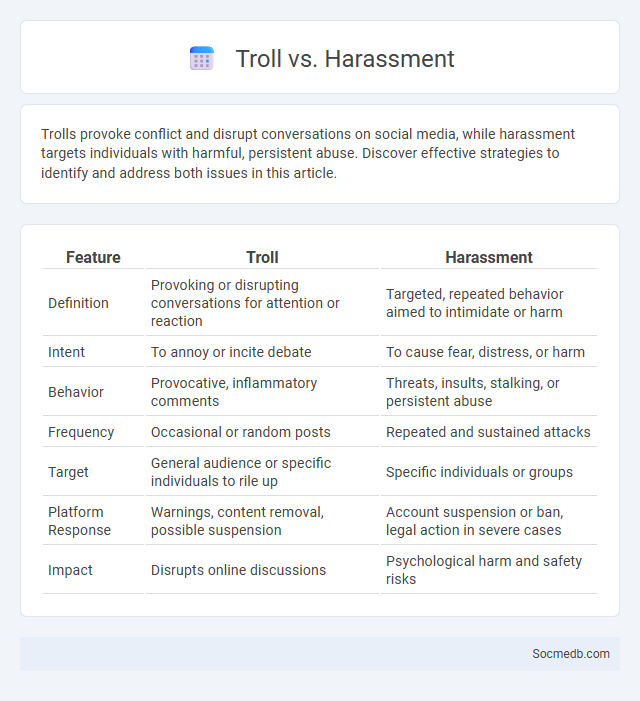
Photo illustration: Troll vs Harassment
Trolls provoke conflict and disrupt conversations on social media, while harassment targets individuals with harmful, persistent abuse. Discover effective strategies to identify and address both issues in this article.
Table of Comparison
| Feature | Troll | Harassment |
|---|---|---|
| Definition | Provoking or disrupting conversations for attention or reaction | Targeted, repeated behavior aimed to intimidate or harm |
| Intent | To annoy or incite debate | To cause fear, distress, or harm |
| Behavior | Provocative, inflammatory comments | Threats, insults, stalking, or persistent abuse |
| Frequency | Occasional or random posts | Repeated and sustained attacks |
| Target | General audience or specific individuals to rile up | Specific individuals or groups |
| Platform Response | Warnings, content removal, possible suspension | Account suspension or ban, legal action in severe cases |
| Impact | Disrupts online discussions | Psychological harm and safety risks |
Understanding the Terminology: Troll vs Harassment
Understanding the terminology surrounding social media interactions is crucial for navigating your online presence safely. A troll intentionally provokes or disrupts conversations with inflammatory or off-topic messages, while harassment involves persistent and targeted abusive behavior causing distress or harm. Recognizing these distinctions helps you identify and respond appropriately to protect your digital well-being.
Defining a Troll: Traits and Motivations
A troll in social media is an individual who intentionally provokes, disrupts, or harasses online communities by posting inflammatory or off-topic messages. Common traits include anonymity, a desire for attention, and a lack of empathy, often fueled by motivations such as amusement, revenge, or a need to manipulate conversations. Understanding these behaviors helps you manage interactions and protect your digital environment from harmful trolling activities.
What Constitutes Harassment Online?
Harassment online constitutes repeated, unwanted behavior targeting an individual or group that causes emotional distress or fear, including threats, insults, stalking, and spreading false information. Platforms often define harassment by the intent to intimidate, degrade, or humiliate, encompassing actions like cyberbullying, doxxing, and hate speech. Legal frameworks and social media policies classify behaviors based on severity, frequency, and impact to effectively address and mitigate online harassment.
Key Differences Between Trolling and Harassment
Trolling involves provoking or annoying others online for amusement or reaction, often characterized by sarcastic or inflammatory comments. Harassment is targeted, persistent behavior intended to intimidate, threaten, or harm someone, frequently violating platform policies and legal standards. Understanding these distinctions helps you identify harmful conduct and take appropriate action to protect your online well-being.
Psychological Impacts of Trolling vs Harassment
Trolling often involves provoking reactions through disruptive or sarcastic comments, leading to temporary emotional distress and increased anxiety. Harassment, however, causes severe psychological impacts including chronic stress, depression, and diminished self-esteem, with long-lasting effects on mental health. Your exposure to either can affect emotional resilience differently, with harassment posing more profound threats to psychological well-being.
Recognizing Troll Behaviors in Digital Spaces
Recognizing troll behaviors in digital spaces involves identifying patterns such as aggressive comments, off-topic posts, and provoking emotional reactions. Trolls often use anonymity to spread misinformation, disrupt conversations, and escalate conflicts intentionally. Awareness of these behaviors enhances online community safety and promotes healthier digital interactions.
Escalation: When Trolling Turns Into Harassment
Escalation from trolling to harassment on social media often involves repeated, targeted attacks that cause emotional distress and violate platform policies. Your ability to recognize warning signs and use tools like blocking, reporting, and privacy settings can help prevent further abuse. Understanding the legal implications and seeking support from online communities or professionals is crucial in managing serious online harassment incidents.
Legal Perspectives: Is Trolling or Harassment a Crime?
Trolling and harassment on social media can constitute criminal offenses under various laws, as they often involve cyberbullying, defamation, or hate speech. Legal frameworks like the Computer Fraud and Abuse Act in the US, the Malicious Communications Act in the UK, and the IT Act in India provide grounds for prosecution when online behavior causes significant harm or distress. Courts increasingly recognize the potential for psychological damage, leading to stricter enforcement and higher penalties against perpetrators of digital harassment.
Strategies for Dealing with Trolls and Harassers
Effective strategies for dealing with trolls and harassers on social media include implementing robust moderation tools such as keyword filters and automated blocklists to minimize exposure to harmful content. Encouraging users to report abusive behavior promptly enables platforms to take swift action, including account suspension or banning repeat offenders. Educating communities on digital etiquette and promoting bystander intervention can significantly reduce the impact of online harassment and foster a safer social media environment.
Building Safer Online Communities: Prevention and Response
Building safer online communities involves implementing advanced content moderation tools powered by AI to detect and remove harmful behavior promptly. Establishing clear community guidelines and promoting digital literacy empower users to recognize and report abuse, fostering respectful interactions. Collaboration between platforms, law enforcement, and mental health organizations enhances prevention efforts and ensures effective response to online threats.
 socmedb.com
socmedb.com